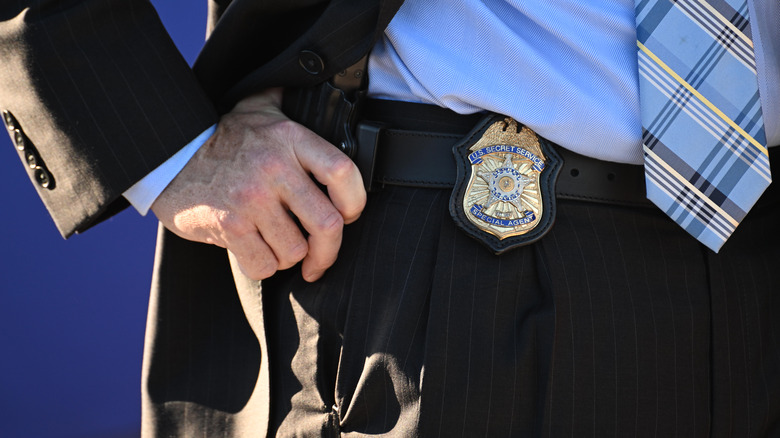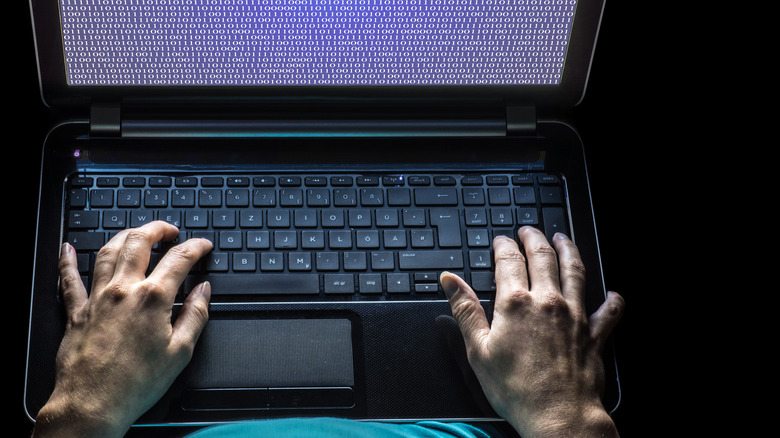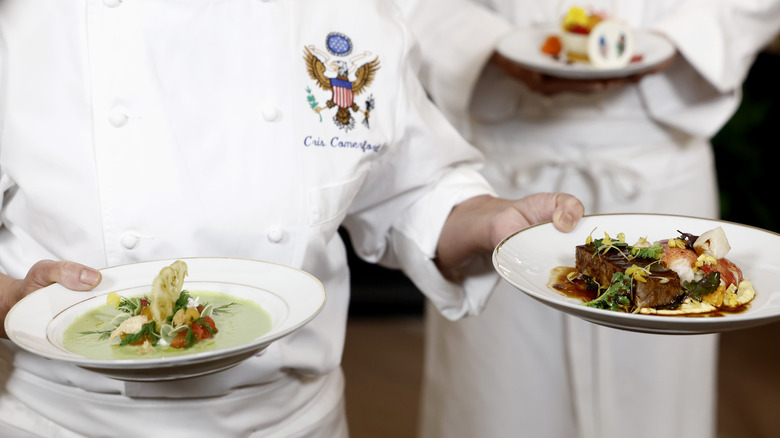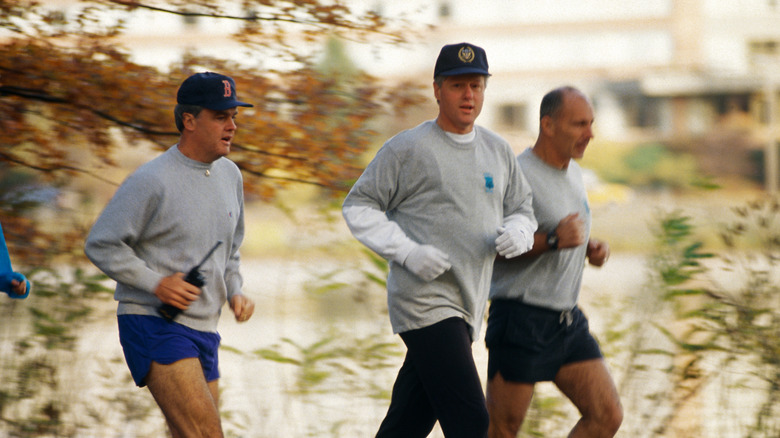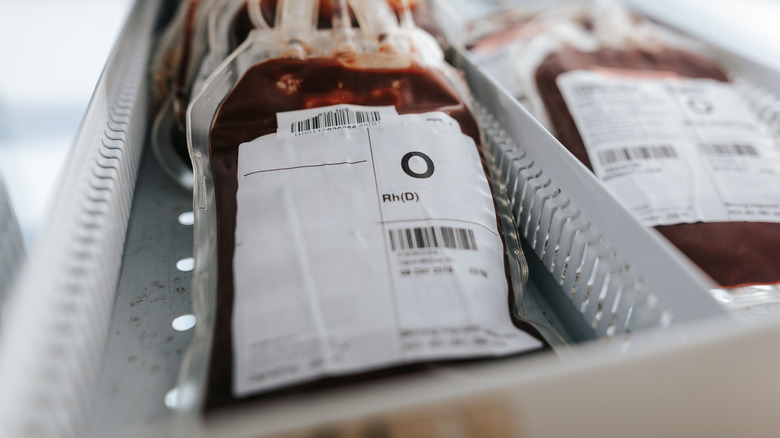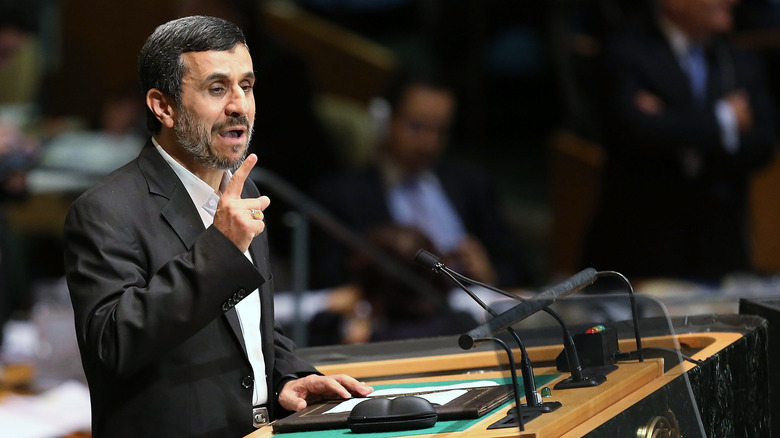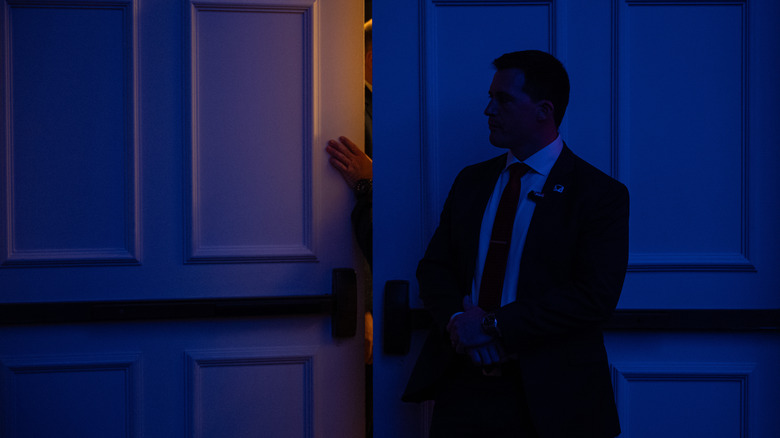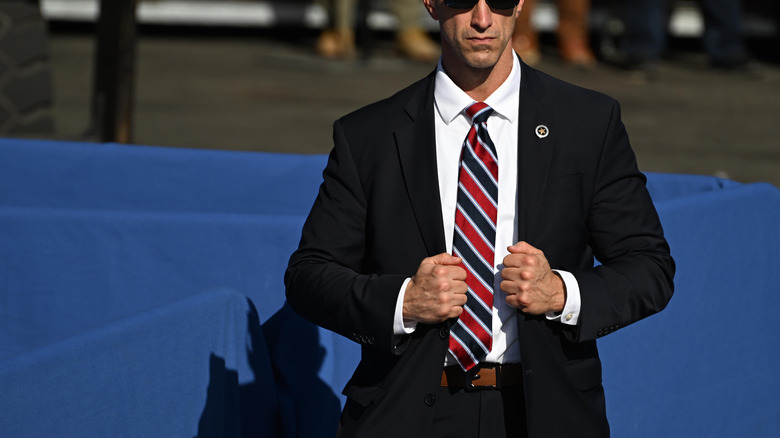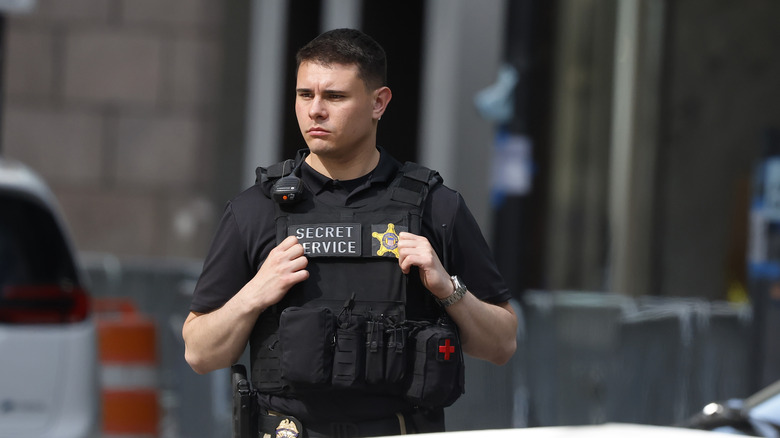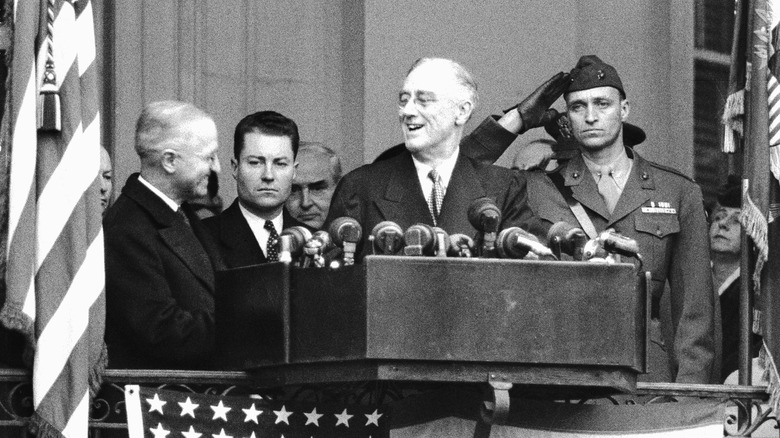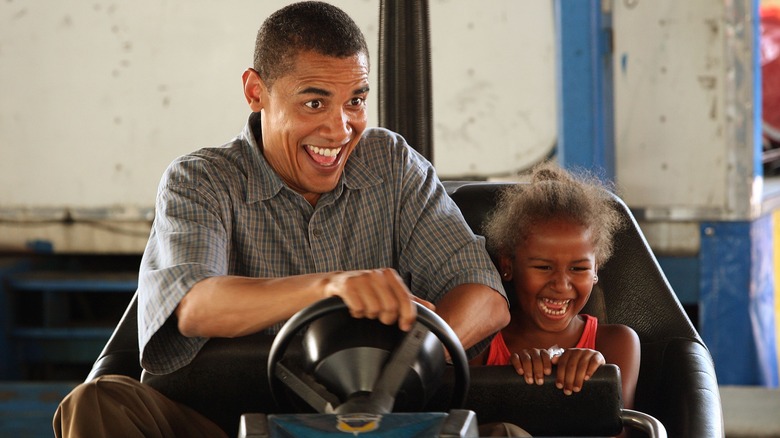Weird Rules The Secret Service Has To Follow
Going off of television and film, it may first seem as if being a Secret Service agent is a pretty glamorous, even noble job. You get to wear a suit and do all sorts of things to protect high-level state officials, from speaking into a wrist microphone to tackling the President of the United States to the ground (and maybe even getting a medal for your efforts). But, the reality of joining the United States Secret Service is far more complicated and can involve navigating a bevy of false facts and common misconceptions about what it really means to be an agent. It can also be potentially emotionally draining. As former agent Jonathan Wackrow told Vanity Fair, employment with the Secret Service can be best described as "prolonged periods of boredom only broken up by moments of sheer terror."
Sometimes, being a member of the Secret Service can also get a bit odd. Still, those rules, offbeat or otherwise, are pretty important. After all, are you any good at being an agent if you let the person you're protecting run low on spare blood or allow them to do something as audaciously dangerous as driving to the grocery store? From the required amount of desk time to sometimes getting uncomfortably close with the president and other notables, these are some of the weird rules Secret Service agents often have to follow.
They may have to be mostly desk-bound for a time
As much as popular images of the Secret Service have suit-clad agents glaring at crowds through their dark sunglasses, the reality — at least at the beginning of an agent's career — is more likely to include a desk and computer monitor. For anyone who has a starry-eyed idea of what it means to be a Secret Service agent (and who manages to maintain that fantasy through training), reality can come crashing down as they're escorted to a quiet office.
Perhaps the weirdest aspect of this rule is that even the toughest agents had to start their careers as desk jockeys. That is, even those who are dead-set on getting involved with protective details must put in two years on the investigation side of things, according to a retired Secret Service agent interviewed in 2013 (via Forbes).
Speaking to Smithsonian Magazine in 2007, agent Julia Pierson noted that even field agents have to do their time, with about half of their work involving investigation rather than protection. Sometimes, that can be fairly active and will involve serving warrants and tracking down criminals. On other occasions, however, that also involves tracking internet-based crimes like counterfeiting and issues with electronic devices. All of this surely dictates that an agent spends a significant amount of their career typing away at a keyboard. They may also be tied up in the bane of many office workers: seemingly endless meetings, interviews, and briefings.
Agents may be expected to monitor the president's food
In the past, much has been made of the rumor that there's an official food taster for the president. Back in 2013, the Daily Caller even reported that President Obama was unable to enjoy the food at a Senate event, with Maine Senator Susan Collins claiming that "He honestly did look longingly at it, but apparently he has to have essentially a taster."
However, as former White House chef Walter Scheib told the Washingtonian, there is no medieval-style poison tester who arrives early and samples the president's food (though other world leaders like Vladimir Putin do reportedly use food tasters). Yet, it's not as if the president necessarily gets to eat whatever they want without some oversight. Scheib claimed that there are definitely security protocols concerning just how a president's food is secured and prepared, a duty that presumably falls at least partially under the jurisdiction of the Secret Service (though Scheib couldn't go into too much detail for security reasons).
And while food service staff at the White House are reportedly already cleared and don't have an agent hanging around them, that may not be the case when the president travels to less secure locations like on foreign state visits or even to a local restaurant. Secret Service agents do indeed go in ahead of the First Couple and other notables to ensure that a restaurant is secure, which likely means a close inspection of the kitchen and its contents.
They could be forced to take up a new exercise routine
If a Secret Service agent lands one of the most serious jobs in the service — protecting the President of the United States — they may find that they're scanning for threats while undertaking a new physical activity. That shouldn't be too much of an obstacle from a fitness standpoint, as agents are expected to maintain a high level of physical fitness, but it's not as if those standards necessarily include galloping about the countryside with Ronald Reagan.
Only, that's just what happened to agents who accompanied President Reagan to his private ranch near Santa Barbara, Rancho del Cielo. Some had a difficult time keeping up with Reagan, who was an avid horse rider. One unfortunate agent even suffered a broken arm after falling from the saddle. Thankfully, agent John Barletta had horse riding experience and became Reagan's frequent companion on the president's rides in the countryside.
When Bill Clinton was running for office in 1992, agents were obliged to go on regular public jogs where Clinton often spontaneously met with members of the public. It wasn't just that they had to run three miles or so that made things tricky; instead, it was the fact that agents also had to carry around radios and sidearms while keeping pace. George W. Bush proved to be an even faster runner, but at least he kept his runs to more easily controlled nonpublic areas such as at the private Camp David retreat.
They may need to watch over bags of blood
Knowing the sort of training that Secret Service agents receive — which includes emergency medicine training — it's unlikely any agent is all that squeamish. Still, for anyone who opens up the right compartment in the presidential limo, the sight of blood bags is sure to induce a moment of unease.
There's a good reason they need to tote around spare blood, however. The heavily armored presidential limo, popularly known as the Beast, includes not just medical equipment, but a fridge stocked with bags of blood that match the president's blood type. In case of an emergency, that blood so carefully watched over by the Secret Service agents could mean the difference between life or death for the president.
Currently, it's unclear if that supply of blood has ever been used, but the medical knowledge of Secret Service agents has definitely saved the president's life on at least one occasion. When President Reagan was shot by would-be assassin John Hinckley Jr. in 1981, agents quickly bundled the president into his limo and sped off towards the White House. According to the book "Standing Next to History: An Agent's Life Inside the Secret Service," en route, agent Jerry Parr noticed the president had "deep-red, foamy blood" coming from his mouth. He quickly deduced that this was due to a serious lung injury and redirected the limo to a nearby hospital, where Reagan went into emergency surgery to remove a bullet from his lung. Without Parr's training and quick reactions, it's possible that Reagan would have died.
An agent may be ordered to guard surprising people
The Secret Service was founded in 1865 to fight counterfeiters and only took on protective work after President William McKinley was assassinated in 1901. Over the years, the types of people watched over by agents have grown to include the vice president, presidential candidates, former presidents, and their immediate family. Adult children of sitting presidents and even recently out-of-office ones can also get this level of protection, including the college-aged children of both George W. Bush and Barack Obama shortly after their fathers' terms ended.
Secret Service agents may also escort foreign heads of state (as well as their spouses) while they're in the U.S. This included Iranian president Mahmoud Ahmadinejad in 2010, who reportedly got so close to his Secret Service detail that he rather warmly asked about their children and called an agent by his first name. That's all the more surprising given Ahmadinejad's oftentimes prickly stance towards the U.S. and his championing of Iran's nuclear program, a development that set the U.S. and its allies on edge.
Still, when Ahmadinejad visited New York City to address the United Nations, he was provided with a Secret Service detail. It would hardly be a good look for the U.S. if any foreign head of state were to be harmed while in the country, so agents may be tasked with protecting someone whose point of view and even personality may rankle their personal sensibilities.
They accompany the president to doctor appointments and sometimes even the bathroom
Part of being a Secret Service agent on the president's protective detail means that you must ensure the president is almost never left alone. That's led to some intimate moments, as when an agent accompanied President Reagan to his colonoscopy, per Mental Floss. Of course, there's no shame in Reagan getting an important medical screening, but surely the situation was made somewhat more tense by the highly alert and very definitely armed agent in the exam room.
Sometimes, agents have also had to accompany the president to the bathroom. If they didn't, occasionally confusion would reign. As George Rush explained in "Confessions of an Ex-Secret Service Agent," President Jimmy Carter once accidentally hit a panic button, thinking it was a toilet flusher. He was therefore very surprised when agent Marty Venker rushed into the bathroom while Carter was still zipping up.
Perhaps that embarrassing incident wasn't as bad as that endured by Secret Service agents who sometimes shielded President Lyndon B. Johnson when he insisted on using the bathroom out of doors. When one agent found that his pant leg was growing wet, he quickly informed Johnson, who reportedly smiled and told him "I know I am. That's my prerogative" (via "Commander in Chief"). However, as former Secret Service agent Jonathan Wackrow told Vanity Fair, agents do their best to give the president privacy, at least in highly controlled private spaces such as the residential areas of the White House.
They must learn to be hungry and sleep deprived on the job
A Secret Service agent on a protective detail can't allow themselves to be distracted. Yet they don't necessarily get breaks and they may not even get the chance to eat or sleep as they regularly would. As former Secret Service agent Dan Emmett claimed in The Wall Street Journal in 2014, agents may be expected to skip multiple meals in a row, stay awake for 24 hours, and work a grueling series of shifts that sometimes requires them to stay awake in the wee hours of the morning ... and then switch to a completely different shift soon after.
Of course, that introduces a set of serious distractions in the form of hunger and sleep deprivation. While it's clear that Secret Service agents who are on the intense assignment of protective duty can and often do deal with it well enough at the time, Emmett noted that many burn out sometime around the five-year mark. Speaking to The Hill, he said that routine travel means "You're constantly in a state of sleep deprivation and jet lag and malnourishment, almost," but that there are times in which responsible agents will take the opportunity to recover. "[You] learn that you can't really be at the peak of your game all the time, or you burn out. You have to understand when it's time to ramp it up and when it's permissible to back down a little bit," he said.
Agents routinely film the president
In the modern era, it turns out that film is a handy part of the Secret Service agent's toolkit. However, it's not as if an agent must constantly record what the president is doing (that's likely already accomplished in one form or another by staff, reporters, archivists, and members of the public, and agents themselves try to at least occasionally give the president some space). Instead, as author Ronald Kessler told Mental Floss, Secret Service agents are more likely to film relatively large public events involving presidential security, such as motorcades. If something happens — as when someone in Florida threw an object at President Donald Trump's procession of vehicles in 2017 — agents can review the footage and come out of it with new security lessons. They can also work to apprehend attackers, as happened with the 2017 motorcade incident.
Footage can be a valuable training tool for a long time after it's been captured, as well. Kessler noted that agents still review the infamous Zapruder film, which graphically captured the moment of JFK's 1963 assassination in Dallas. The moments before and after Kennedy's shooting still hold valuable lessons for how Secret Service agents can react to such a dire situation — and especially how to prevent it in the first place.
Agents may be tasked with protecting the president's image
While movies like Clint Eastwood's 1993 film, "In the Line of Fire" may show Secret Service agents as macho heroes willing to put their very bodies on the line to protect the president, the reality is that sometimes they also have to consider the softer side of things when on protective detail. In other words, they have to consider one of the most key things about the office: the president's image.
Take the now well-known case of President Franklin D. Roosevelt's disability. The commonly accepted notion that Roosevelt's mobility issues — caused by a 1921 bout with polio as a middle-aged adult — were often hidden by the press is often overstated. The reality is that reporters covering his time in office did sometimes mention the president's usage of a wheelchair and other mobility aids, such as canes and leg braces.
However, it is true that FDR and his staff generally wanted to convince America he could walk just fine, so they weren't exactly open with all information about his disability, especially when it came to publishing images of the president using those mobility aids. Secret Service agents reportedly sometimes ripped recording equipment from peoples' hands, destroying the film then and there. However, even the Secret Service couldn't get it all, as the occasional footage (sometimes shot from a distance) made its way to unsympathetic members of the press corps.
They have to kick the president out of the driver's seat
One of the many rules that the first family must follow concerns their ability to get behind the wheel. While spouses and grown children might get some leeway, the general rule is that the president, vice president, and former holders of those roles are no longer allowed to drive on public roads. It's not a law, exactly, but the Secret Service and other security officials strongly discourage presidents from sitting in the driver's seat. Instead, an agent with training in defensive driving tactics is meant to chauffeur them around. Even on private roads, protectees are typically accompanied by an agent.
That rule is one that agents often enforce even after a president is out of office. The Former Presidents Act, passed in 1958, currently provides lifetime protection for former U.S. heads of state, both to keep them safe and to keep their knowledge of state secrets and the inner workings of the government in the right hands. It also provides former presidents with an annual allowance, office space, and office staff.
This protection both during and after the presidency means that many officeholders have only fleeting experiences in the driver's seat, even after the White House is in their rearview mirror. Thus, you have President Obama fondly recalling the time he took a Chevy Volt for a gentle spin around the White House grounds, though anxious agents closed gates between him and public roads (via USA Today).
